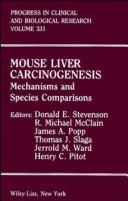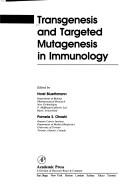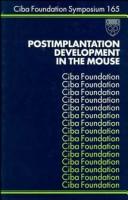| Listing 1 - 10 of 25 | << page >> |
Sort by
|
Image
Year: 1594 Publisher: Assuerus van Londerseel
Abstract | Keywords | Export | Availability | Bookmark
Image
Year: 1594 Publisher: Assuerus van Londerseel
Abstract | Keywords | Export | Availability | Bookmark
 Loading...
Loading...Choose an application
- Reference Manager
- EndNote
- RefWorks (Direct export to RefWorks)
Flowers --- Insects --- Mice --- Amphibians
Image
Year: 1594 Publisher: Assuerus van Londerseel
Abstract | Keywords | Export | Availability | Bookmark

ISBN: 0471566950 Year: 1990 Publisher: New York Wiley-Liss
Abstract | Keywords | Export | Availability | Bookmark
 Loading...
Loading...Choose an application
- Reference Manager
- EndNote
- RefWorks (Direct export to RefWorks)

ISBN: 0121057607 1322480338 1483296490 Year: 1994 Publisher: New York, NY : Academic Press,
Abstract | Keywords | Export | Availability | Bookmark
 Loading...
Loading...Choose an application
- Reference Manager
- EndNote
- RefWorks (Direct export to RefWorks)
Animal genetics. Animal evolution --- Immunology. Immunopathology --- Mice [Transgenic ] --- Muizen [Transgenetische ] --- Souris transgenetiques --- Transgenetische muizen --- Transgenic mice --- Mice --- Immunology --- Animal models --- Transgenic mice. --- Mice - Immunology. --- Immunology - Animal models.
Dissertation
ISBN: 9789086496655 Year: 2014 Publisher: Leuven KU Leuven. Faculteit Wetenschappen
Abstract | Keywords | Export | Availability | Bookmark
 Loading...
Loading...Choose an application
- Reference Manager
- EndNote
- RefWorks (Direct export to RefWorks)
Neuroplasticity in the brain is dynamically controlled in space and time. Different permissive factors and molecular brakes establish and eventually stabilize optimal functional networks in such a way that they are still capable to adapt in response to experience. The visual cortex has been a valuable research model to study neocortical development, function and plasticity from mice to men. For instance, partial loss of vision by monocular enucleation (ME) early in life and in adulthood has been linked to widespread structural and functional reorganization in the visual cortex after short- and long-term survival times. However, the deprivation effects in ages that represent adolescence and cortical changes along the full extent of the visual and non-visual cortices are often overlooked. In that regard we initiated this doctoral project to fulfill these shortcomings. In adult mice, complete reactivation of deprived visual cortex involves an early visually driven recovery followed by multimodal plasticity 3 to 7 weeks post-ME and had been discovered at the beginning of this investigation. We have specifically investigated the age dependence of the onset and the exact timing of both ME-induced reactivation processes by comparing cortical activity patterns of mice enucleated at postnatal day 45 (adolescence) or 120 (adult). Radioactive in situ hybridization for the activity reporter gene zif268 in the visual cortex of adolescent and adult ME mice revealed striking differences. A swifter open-eye potentiated reactivation, between 3 and 5 days, characterized the binocular visual cortex of adolescent mice yet even after 7 weeks, the reactivation remained incomplete, especially in the medial monocular cortex. Consequently, we wondered to what extent monocular enucleation in mice of intermediate age group would induce enucleation-enabled plasticity. In comparison to adolescence, emergent cross-modal participation was demonstrated in P90 animals, although robust reactivation similar to enucleated adults was not achieved yet. Concomitantly, 7 weeks post-ME, somatosensory and auditory cortex shifted from a hypoactive state in adolescence to hyperactivity in adulthood. Thus, we provide evidence for a pre-sensitive period in which gradual recruitment of cross-modal recovery upon long-term monocular enucleation coincides with the transition from adolescence to adulthood in mice. In other words, the cross-modal recruitment of visual cortex following late onset vision loss, at least for monocular enucleation, is stronger in adults.Since the cellular and molecular players that regulate co-occurrence of uni- and cross-modal plasticity specifically in adulthood remain largely elusive, a second aim of this thesis was to apply dark exposure, a housing strategy known to shift the cortical excitation-inhibition balance, as a tool to study the role of the GABAergic system in the age-dependent aspect of ME-induced plasticity. We examined if dark exposure has an impact on the visual cortex reactivation by placing mice in total darkness for 10 days prior to monocular enucleation. Intriguingly, dark exposure converted the outcome of monocular enucleation in adult mice into a more adolescent-like response. A permanent deficit in neuronal activity was detected, most likely reflecting the absence of the cross-modal facet of reactivation due to dark exposure. At the molecular level, monocular enucleation preferentially decreased vGAT levels and induced more GABA production via increased GAD65 and GAD67 levels in the medial monocular cortex. Yet these changes at the presynaptic site were independent of age or dark exposure. However, at the postsynaptic site, elevated levels of the GABAA receptor alpha 1 subunit (mediating phasic inhibition) but not the delta subunit (mediating tonic inhibition), specifically characterized incomplete reactivation like in dark exposed and adolescent mice. Together, our molecular observations put the level of intracortical phasic inhibition forward as an important permissive factor for the age- and experience-dependent cross-modal response to long-term monocular enucleation.To conclude, monocular enucleation as well as dark exposure in the mouse will definitely be outstanding animal models to further decipher the cellular and molecular basis for the age- and experience-dependent response of the visual cortex to deprivation or lesions. In addition, they can enrich our understanding of cross-modal interactions and plasticity, in the emerging context of a high incidence of multimodal neurons and areas in the rodent and higher-order mammalian neocortex, including human.
Image
Year: 1594 Publisher: Assuerus van Londerseel
Abstract | Keywords | Export | Availability | Bookmark
 Loading...
Loading...Choose an application
- Reference Manager
- EndNote
- RefWorks (Direct export to RefWorks)

ISBN: 0471933848 Year: 1992 Volume: vol 165 Publisher: New York, NY ; Chichester : John Wiley,
Abstract | Keywords | Export | Availability | Bookmark
 Loading...
Loading...Choose an application
- Reference Manager
- EndNote
- RefWorks (Direct export to RefWorks)
Mice --- Embryos --- Congresses --- Development --- Developmental cytology --- Physiology --- Mice - Embryos - Congresses. --- Mice - Development - Congresses. --- Developmental cytology - Congresses. --- Mice - Embryos - Physiology - Congresses. --- EMBRYO --- GENE EXPRESSION --- MICE --- POSTIMPLANTATION PHASE --- GROWTH AND DEVELOPMENT --- CONGRESSES --- EMBRYOLOGY --- PHYSIOLOGY
Dissertation
Year: 1997 Publisher: Gembloux Faculté universitaire des sciences agronomiques de Gembloux
Abstract | Keywords | Export | Availability | Bookmark
 Loading...
Loading...Choose an application
- Reference Manager
- EndNote
- RefWorks (Direct export to RefWorks)
Chlamydia trachomatis --- Chlamydia infections --- Immunological aspects --- Chlamydia infections --- Animal models --- Generative organs [Female ] --- Infections --- Infertility [Female ] --- Mice --- Generative organs --- Infections --- Mice --- Immunology --- Mice as laboratory animals
Dissertation
ISBN: 9789086496594 Year: 2013 Publisher: Leuven KU Leuven. Faculteit Wetenschappen
Abstract | Keywords | Export | Availability | Bookmark
 Loading...
Loading...Choose an application
- Reference Manager
- EndNote
- RefWorks (Direct export to RefWorks)
Academic collection --- 599.323.4 --- 591.48 --- Muridae. Mice. Rats. Hamsters. Voles. Lemmings. Field-mice. House-mice. Gerbil. Water-rat. Ondatra --- Nervous system --- Theses --- 591.48 Nervous system --- 599.323.4 Muridae. Mice. Rats. Hamsters. Voles. Lemmings. Field-mice. House-mice. Gerbil. Water-rat. Ondatra
| Listing 1 - 10 of 25 | << page >> |
Sort by
|

 Search
Search Feedback
Feedback About UniCat
About UniCat  Help
Help News
News